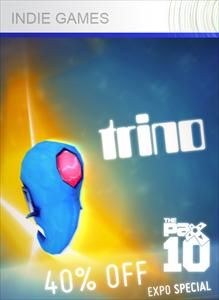Retro Replay Review
Gameplay
Trino delivers a refreshingly minimalist puzzle experience centered around the simple yet endlessly versatile concept of creating triangles to ensnare foes. Each level unfolds on a single screen, where you place vertices and connect them to form triangular traps that capture roaming Nanites. The core mechanic is intuitive—tap to add points, then link them in any order—but as you progress through the 48 levels, what begins as a straightforward exercise becomes a master class in spatial reasoning and strategic planning.
(HEY YOU!! We hope you enjoy! We try not to run ads. So basically, this is a very expensive hobby running this site. Please consider joining us for updates, forums, and more. Network w/ us to make some cash or friends while retro gaming, and you can win some free retro games for posting. Okay, carry on 👍)
The game is structured into three distinct chapters, each introducing new challenges and enemy types. Early stages teach you the basics: how to lay down the initial three points, how to close a triangle, and how to anticipate enemy movement. Boss levels, interspersed every 15 regular stages, force you to rethink your approach by pitting you against Nanites with unique behaviors such as splitting into smaller units or phasing through completed triangles. This steady ramp-up of complexity keeps the puzzles from ever overstaying their welcome.
Adding to the depth is the evolution of Trino itself. As you capture more enemies, you unlock extra vertices and special powers—ranging from temporary shields to point-freeze zones—that can dramatically alter the puzzle dynamic. Learning when to deploy these abilities is half the fun, and mastering them transforms Trino from a one-trick alien into a bona fide nano-battling strategist. For players who love trial-and-error and deriving satisfaction from incremental progress, Trino’s gameplay loop is pure gold.
Graphics
Visually, Trino sports a clean, polished 2D aesthetic that emphasizes clarity over flash. The titular blue alien stands out crisply against the darker backgrounds populated by metallic Nanites, ensuring you always know exactly what’s happening on-screen. Each enemy type is distinctively colored and animated, so you can quickly learn to identify and counter their behaviors without sifting through visual clutter.
The color palette leans into cool blues and grays punctuated by neon accents every time you deploy a power or complete a level. This restrained approach gives each triangle you draw a satisfying pop of color against a muted backdrop. Tiny particle effects—sparkles when a Nanite is captured, a ripple when you place a new point—add a subtle layer of polish that makes the game world feel alive without distracting from the puzzles themselves.
Animations in Trino are crisp and purposeful. Enemies dart, charge, and split with fluid motion, making it easy to predict their paths and plan accordingly. Transition screens between chapters and boss fights feature simple, elegant UI elements and brief narrative captions that maintain immersion without breaking the game’s fast-paced rhythm. In short, the graphics are a masterclass in functional design that looks great while serving the gameplay at every turn.
Story
Trino’s narrative is deceptively simple: a curious little blue alien wanders into the domain of the Nanites, who see it as an existential threat and promptly lock it away. From there, the story unfolds level by level, with each chapter representing Trino’s gradual push toward freedom. It’s an archetypal “underdog against the machine” tale, but the game never bogs you down with cutscenes or lengthy exposition.
Dialogue comes in short bursts of text between levels, describing Trino’s thoughts or the Nanites’ cold, robotic warnings. While minimal, these snippets underscore the stakes—Trino’s survival—and give a touch of personality to both protagonist and antagonists. Boss encounters, in particular, are framed by small narrative beats that make each showdown feel like a meaningful escalation in the alien’s escape plan.
What truly sells Trino’s story is how it interweaves with the puzzles themselves. Each new power-up or vertex upgrade is justified as Trino evolving to outsmart its captors, and the varied behaviors of the 20 Nanite types reinforce the idea of an ever-adapting enemy force. By the time you reach the final boss, you’ve lived through a compact, coherent journey that feels both mechanically and thematically satisfying.
Overall Experience
Trino excels at delivering bite-sized puzzle sessions that never overstay their welcome. Levels typically take only a minute or two to solve once you’ve grasped the trick, making it easy to jump in for a quick brain-teaser or settle in for a longer playthrough. The difficulty curve is well-tuned; early levels are welcoming to newcomers, while later challenges push seasoned puzzle fans to think several steps ahead.
The combination of 45 regular puzzles and three distinct boss fights ensures a solid and varied playtime, and the unlockable powers add a layer of strategy that keeps the experience fresh. Whether you’re racing against the swarm of basic Nanites or wrestling with a boss that demands precise timing and clever trap placement, Trino offers a satisfying blend of tension and reward.
Accessibility is another highlight. With simple touch controls, clear visual feedback, and a forgiving restart mechanic that instantly resets the level upon failure, the game caters to casual players and puzzle veterans alike. Trino’s engaging gameplay, sleek presentation, and compact narrative make it an ideal purchase for anyone seeking a thoughtful, bite-sized challenge wrapped in an adorable alien escapade.
 Retro Replay Retro Replay gaming reviews, news, emulation, geek stuff and more!
Retro Replay Retro Replay gaming reviews, news, emulation, geek stuff and more!







Reviews
There are no reviews yet.